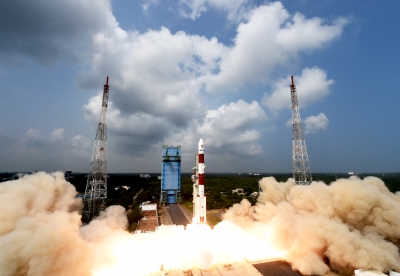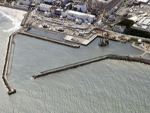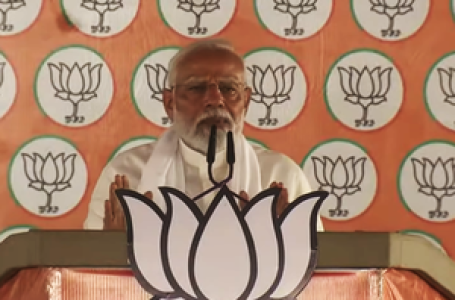
Sriharikota (Andhra Pradesh): India on Saturday successfully placed into orbit the Indo-French ocean observation satellite EOS 06 and eight other nano satellites with its rocket Polar Satellite Launch Vehicle numbered as PSLV-C54.
Announcing the mission’s success, Indian Space Research Organisation (ISRO) Chairman and Secretary, Department of Space, S. Somanath, said all the satellites have been launched.
He also said the solar panels of EOS 06 satellite had been deployed and the satellite was in precise orbit as intended and congratulated the ISRO team.
The XL variant of PSLV rocket carrying the 1,117 kg EOS-6 as its primary passenger and eight others – blasted off from the first launch pad at Satish Dhawan Space Centre (SDSC) here at 11.56 a.m.
The piggybacks include satellites from two Indian startups – Syzygy Space Technologies Pvt Ltd, commonly known as Pixxel (Anand-16.51 kg), and Dhruvaspace’s two Thybolt satellites – 1.45 kg, Spaceflight USA’s Astrosat (four numbers 17.92 kg) and ISRO’s INS-2B (18.28 kg).
About 17 minutes into the flight the rocket ejected EOS-6. Then the orbit was changed by using two Orbit Change Thrusters introduced in the rocket’s propulsion bay ring. The piggyback passengers were ejected in Orbit-2.
The whole mission took about two hours.
With this, the PSLV rocket has put into orbit 349 foreign satellites till date.
When one takes into account the 36 satellites of UK-based OneWeb that were orbited by another rocket LVM3 this year, then the total number of foreign satellites put into orbit by ISRO would go up to 385.
At the end of the final countdown, the four stage expendable, 44.4 m tall XL variant of PSLV rocket weighing 321 ton slowly rose towards the skies with thick orange flame at its tail.
The rocket gained speed as it went up while emitting a rolling thunder sound.
The PSLV rocket is powered by solid (first and third stages) and liquid (second and fourth stages) fuels alternatively.
The rocket that flew on Saturday was the 56th mission of PSLV and 24th mission using the PSLV-XL variant having six strap-on booster motors with six ton fuel.
The ISRO said the Indo French collaborative EOS-06/Oceansat will provide continuity services of Oceansat-2 spacecraft with enhanced payload capabilities and application areas.
The EOS-06 payloads include Ocean Color Monitor (OCM-3), Sea Surface Temperature Monitor (SSTM), Ku-Band Scatterometer (SCAT-3) and ARGOS – a French payload.
According to France, ARGOS will reinforce the existing fleet of Indo-French satellites working on weather surveillance that are already in orbit (MEGHA-TROPIQUES and SARAL-ALTIKA), thus enhancing contributions related to the objectives of the Paris Agreement.
The Indian space agency said the satellite will ensure data continuity of ocean colour and wind vector data to sustain the operational applications. It will also improve the applications, some additional datasets such as Sea Surface Temperature and more bands in Optical region for fluorescence and in Infrared region for atmospheric corrections are accommodated.
The satellite will also develop/improve related algorithms and data products to serve in well established application areas and to enhance the mission utility.
The INS-2B is ISRO’s second nano satellite for Bhutan with two payloads viz., NanoMx and APRS-Digipeater. The NanoMx is a multispectral optical imaging payload developed by its Space Applications Centre (SAC). The APRS-Digipeater payload is jointly developed by DITTBhutan and ISRO’s UR Rao Satellite Centre (URSC), ISRO said.
The Bhutanese Information and Communication Minister Lyonpo Karma Donnen Wangdi who had witnessed the mission from here said, the commendable track record of ISRO in satellite launching left no doubt about the mission’s success.
He said the mission is another key milestone of the close relationship between India and Bhutan.
Wangdi said the satellite was built during the Covid-19 pandemic.
Indian Minister for External Affairs S. Jaishakar said, ISRO is working on setting up a ground station in Bhutan.
The Pixxel’s Anand nanosatellite is a technology demonstrator to demonstrate the capabilities and commercial applications of miniaturized earth-observation camera for earth observation using a microsatellite in Low Earth Orbit. This is a three-axis stabilised satellite consisting of a satbus, accommodating all subsystems like telemetry, tele-command, electrical power system, Attitude Determination and Control System (ADCS), on-board computers and others and a payload unit, ISRO said.
The Dhuruvaspace’s Thybolt satellites have a communication payload to enable rapid technology demonstration and constellation development for multiple users. It also demonstrates Store-and-Forward functionality for authorised users in the amateur frequency band.
Astrocast, a 3U spacecraft, is a technology demonstrator satellite for the Internet of Things (IoT) as the payload.
(Venkatachari Jagannathan can be reached at v.jagannathan@ians.in)
Sriharikota: PSLV-C54 carrying earth observation satellite along with eight other co-passenger satellites after its launch from the Satish Dhawan Space Centre in Sriharikota on Saturday.IANS



















